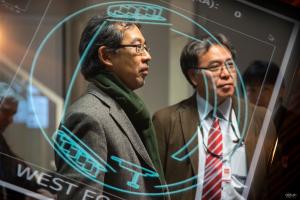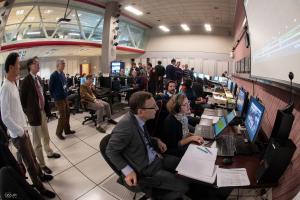Fusion world
WEST tokamak controlled from Japan
3 Dec 2018
On a large video wall in Rokkasho, Japan, a plasma generated in the south of France flashes briefly. Operators are testing remote data acquisition and control techniques—the same techniques that will one day make it possible to carry out experiments on ITER—by demonstrating them on existing devices such as the WEST tokamak.
From the WEST control room in France, observers watch live as Japanese scientists test the data acquisition and control techniques of the Remote Experimentation Centre in Rokkasho (Japan). Photo: Christophe Roux/CEA
The Remote Experimentation Centre (REC) in Japan reproduces the control room of a fusion research facility, with functions for preparing and setting plasma shot parameters, viewing the status of control data, operation monitoring, and data exchanging.
From this space, scientists in Japan will one day participate remotely in ITER experiments.
Before ITER enters operation, the team in Japan is verifying the functions required for remote experimentation by running tests and demonstrations on operating tokamaks such as JET and WEST today, and a little later on JT-60SA*.
On 28 November, the first test was carried on WEST, the Tungsten (W) Environment in Steady-State Tokamak located just a few hundred metres from the ITER campus at the French Institute for Magnetic Fusion Research (IRFM).
On the operational program that day were experiments to expose tungsten-coated components to the high heat flux coming from the WEST plasma. Two IRFM engineers were in Rokkasho to aid their Japanese colleagues in familiarizing themselves with data visualization, plasma shot parameters and, more generally, the organization of the experiment. The choice of experiment was particularly relevant, as ITER Japan has provided three plasma-facing units to WEST.
After the success of this first experience collaboration will be pursued, as operators of the Remote Experimentation Centre continue to test the key elements of remote data acquisition and control techniques, including the software in charge of performing remote experiments, networks, data storage, and fast data transfer.
The WEST-REC tests were financed by the European Domestic Agency, Fusion for Energy, which—in addition to providing Europe's contribution to ITER—also supports fusion R&D through the Broader Approach. Photo: Christophe Roux/CEA
The development of the Remote Experimentation Centre is progressing under the umbrella of the Broader Approach, an agreement between the European Union and Japan that establishes advanced R&D projects in support of ITER and the next-phase device. The centre is one of three projects at the International Fusion Energy Research Centre (IFERC) in Rokkasho.
*The JT-60SA tokamak, which will come on line in 2020, also falls under the umbrella of the Broader Approach agreement. Read more about assembly activities underway here.
You can also read the news in French.



